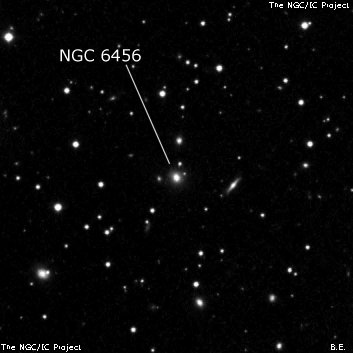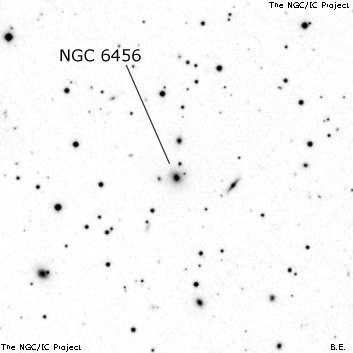NGC/IC Project Restoration Effort
(This is a very very beta version)
NGC6456


Basic Information
Location and Magnitude
Right Ascension: 17:42:31.7
Declination: +67:35:32
Constellation: DRA
Visual Magnitude: 14.8
Historic Information
Discoverer: Swift L.
Year of discovery: 1886
Discovery aperture: 16.0
Observational
Summary description: eeF, eS, R, v diffic, bet 2 st
Sub-type: E3
Corwin's Notes
=====
NGC 6456, 6463, 6470, 6471, 6472, and 6477. Here is another mess from Lewis
Swift's 4th and 5th lists of nebulae. NGC 6463 and NGC 6470 were found on 9
June 1886, the remainder on 25 September 1886. All of Swift's positions fall
within a group of (at least) eight galaxies. It's possible that Swift could
have seen most of the objects, but only after seeing the DSS image from the
POSS-II plate could I assign his numbers with any confidence to the galaxies.
I also have to thank Brian Skiff for asking about the field; his questions
forced a re-evaluation that I otherwise might not have made.
The descriptions don't help much. All the galaxies are "eeeF, eS, R" or a
close variation, and all are noted "v dif[ficult]" to "eee dif". Swift
does mention that the preceding of the group is "bet[ween] 2 sts" -- but
since the Galactic latitude is so low, there are enough stars around for that
description to apply to virtually any of the galaxies in the group. Dreyer
added the note "* nr" to N6471 and N6477; this is not in Swift's original
paper, so it must be from a letter from Swift to Dreyer.
In any event, there is not much to go on here that will help us assign the NGC
numbers to the correct objects. If we make some reasonable assumptions -- 1)
Swift saw the two brightest galaxies on his first sweep through the area, 2)
he did in fact see all six 3.5 months later, and 3) his relative positions for
the remaining four galaxies seen only the second night are more or less
accurate -- then we can make a stab at some identifications. These are not
certain by any means, and they do not agree with some previous
identifications.
However, they do make sense of Swift's data. On the first night, he saw the
two brightest objects in the core of the group, N6463 and N6470. N6456 is
reasonably isolated to the west of the core, and N6471 and N6472 flank N6470
in declination. They are also the brightest galaxies in the core after N6463
and N6470. It also is reasonable to suppose that both components of UGC 10973
contributed to the visual appearance of N6471, so I've listed both in the main
table. I'm least certain about N6477, but Swift's observation places it
following N6470/1/2, and between N6472 and N6470 in declination. The galaxy
I've chosen matches these constraints -- but its position is still well off
Swift's place.
For reference, here is a table of B1950.0 positions -- Swift's on the first
line and accurate positions on the second -- of my suggested identifications.
Object RA (Swift) Dec Discovered Other names and comments
(Modern) Pos source
V 76 17 42 29 +67 37.7 25 Sept 1886 CGCG 321-034
N6456 17 42 39.60 +67 36 48.6 GSC
IV 55 17 43 44 +67 36.5 9 June 1886 CGCG 321-037 = MCG +11-21-022
N6463 17 43 42.27 +67 37 24.2 GSC
IV 56 17 44 19 +67 37.8 9 June 1886 CGCG 321-039 = MCG +11-21-025
N6470 17 44 22.98 +67 38 18.3 GSC
V 78 17 44 19 +67 36.4 25 Sept 1886 UGC 10973a = CGCG 321-038w =
N6471w 17 44 20.89 +67 36 44.0 GSC = MCG +11-21-023
N6471e 17 44 26.06 +67 36 36.6 GSC UGC 10973b = CGCG 321-038e =
= MCG +11-21-024
V 79 17 44 19 +67 39.9 25 Sept 1886
N6472 17 44 11.31 +67 38 58.5 NPM1 = NPM1G +67.0154
V 80 17 44 54 +67 39.2 25 Sept 1886
N6477: 17 44 38.38 +67 37 44.3 HCds
Other possibilities:
17 43 16.26 +67 33 43.7 GSC Star superposed.
17 43 33.48 +67 40 17.4 GSC Extremely compact w vF arms;
star superposed on nucleus?
17 44 51.37 +67 33 33.3 HCds
Steve's Notes
=====
NGC 6456
24" (8/23/14): at 375x appeared fairly faint, fairly small, irregularly round, 20"-24" diameter, slightly brighter middle. A mag 16.6 star is 0.4' N of center.
17.5" (6/11/88): very faint, very small, round, weak concentration. First of 7 and in a trio with NGC 6463 6.0' E and PGC 2701716 6' SE.



